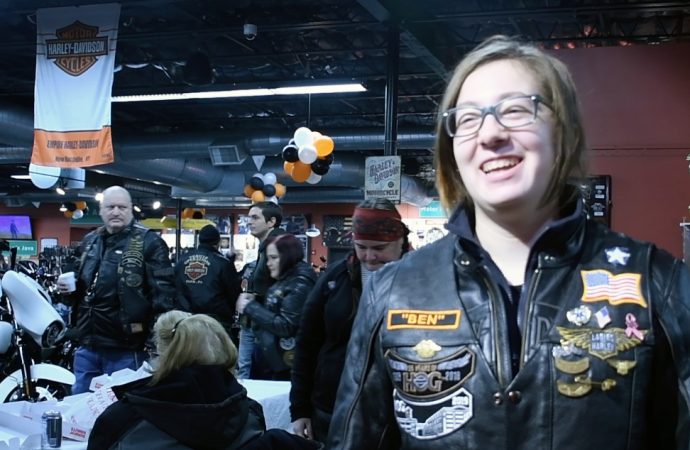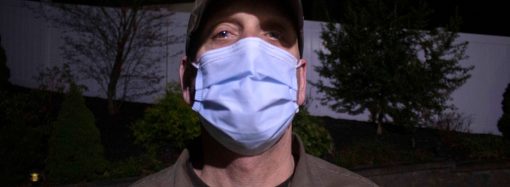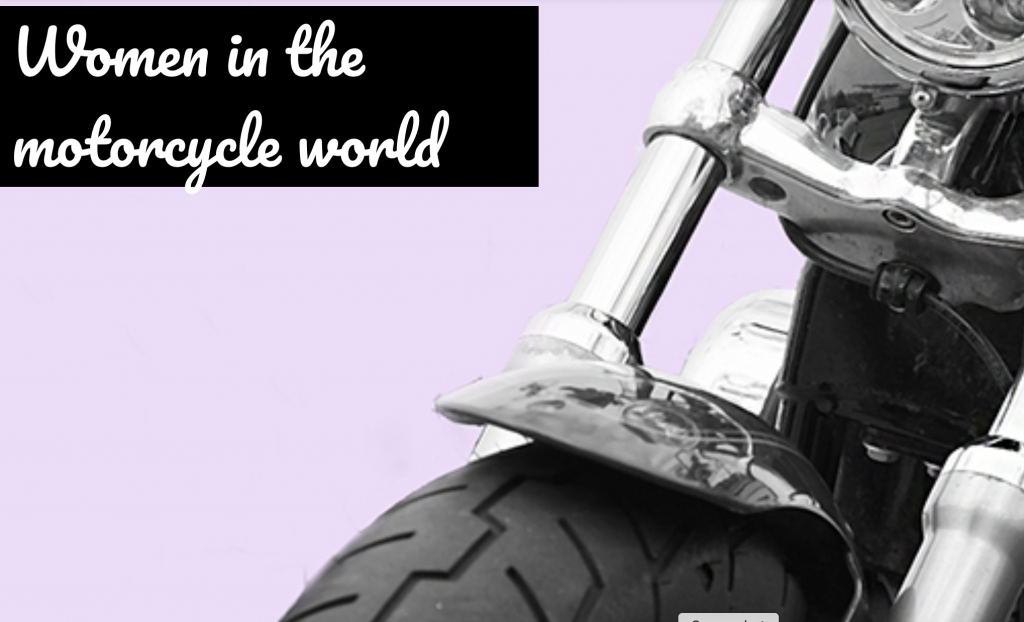
By Andrea Keckley
Spring 2018 JRN 490
One ride on the back of a motorcycle when she was a teenager, and Ronnie Vuolo was hooked. She wouldn’t stay in the passenger’s seat for long.
She got her first bike in 1979 when she was 21 years old – a Suzuki 560 she noticed was on sale.
“When I got the bike, I didn’t have a helmet yet,” she recalled. “And I went up the street to my neighbor… and I said, ‘can I borrow one of your helmets for a couple of days until I get one?’ And I remember them saying, ‘why don’t you just get a boyfriend?’ But I wanted to b able to ride whenever I wanted.”
Vuolo didn’t see any other women riding at first. Eventually, that changed. But many people still weren’t used to seeing a woman holding the handlebars.
“People looked at you really funny if you were a woman on a bike,” she said. “I remember one night… one of my girlfriends… was packing me on the back [of her bike] to go pick up my bike at the Harley dealer, and these guys yelled out their truck window, ‘dikes on bikes!'”
Quite a bit has changed since then – especially in recent years.
“We definitely see more women on the road,” said Vulolo. “You don’t feel like you’re the only one out there.
We definitely see more women on the road. You don’t feel like you’re the only one out there.
Ronnie Vuolo, member of the Motor Maids
Women made up 10 percent of motorcycle owners in 2009, according to the Motorcycle Industry Council (MIC). In 2018, they made up 19 percent.
“When a woman walks in my store, I assume that she’s riding,” said Ken Veale, the owner of Port Jefferson Motorcycle Store. “If she has a helmet in her hand, we used to assume thirty years ago that she was a passenger. Now I ask her, ‘what are you riding?'”
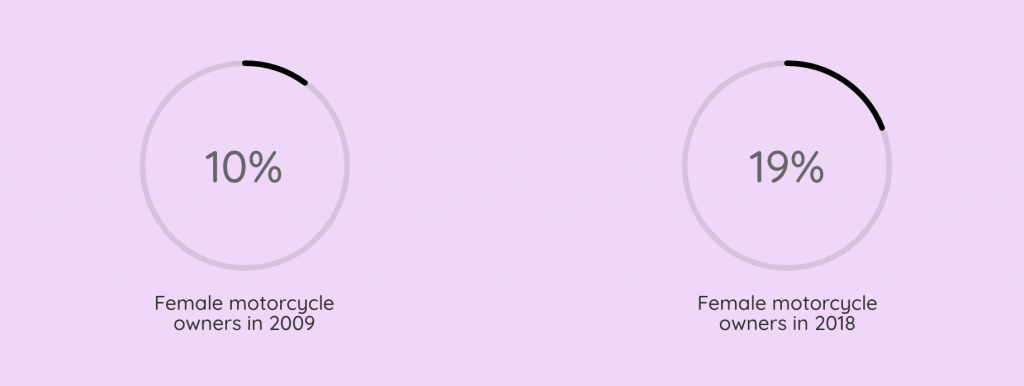
The rise of female motorcycle owners has been good for business. Women, on average, spend more money on motorcycle maintenance, parts, service and accessories than men, according to 2018 statistics by the MIC.
The motorcycle industry has also long been concerned about their aging customer base. But female bikers are, on average, quite younger than their male counterparts. 2014 statistics by the MIC report that the median age for women was 39, compared to 48 for men. Women also make up 22 percent of Gen X and 26 percent of millennial motorcycle owners, according to 2018 statistics by the MIC.
Randy Medina is the Fixed Operations & Marketing Manager at Empire Harley Davidson in New Rochelle. As someone who works in a relatively young and diverse area, he’s seen interest in motorcycles expand beyond its dominant consumer demographics. The store has made many efforts to widen their reach, including hosting family-friendly events.
“It’s more of just not catering to any one member of the family,” sad Medina. “You’re reaching out to everybody in one shot.”
Jen “Ben” Coutsourakis, 18, is a member of the Empire chapter of Harley Owners Group in New Rochelle. She got her first Harley at 17.
“My dad always had them [Harleys] growing up so he would always sit me on his tank and we would go for a ride, so I just grew up on it,” she said.
In 1998, Vuolo joined the all-female motorcycle club, Motor Maids. Established in 1940 by Dot Robinson and Linda Dugeau, it’s one of the oldest clubs recognized by the American Motorcycle Association (AMA). They have more than 13,000 members today.
Groups like these can help women who ride form strong friendships with each other.
“I didn’t have a passion for motorcycling until I got on one myself,” said Deborah Shannon, a member of the Motor Maids. “And it was the women who guided me.”
Members of the Motor Maids wear uniforms consisting of long sleeve blue shirts, white cotton vests, black pants and black boots. When they ride in parades, they also wear white gloves.
“Back in the day, ladies would wear white gloves,” said Doris McCarrick, who joined Motor Maids in December of 2017. “A lot of times you’ll hear people say ‘you’re the ladies with the white gloves!'”
Robinson is often referred to as the first lady of motorcycling. She and Dugeau cared deeply about improving perceptions of women who rode.
“It was very, very important to her that the Motor Maids were ladylike,” said Vuolo.
It’s a goal to which the Motor Maids still hold today.
“It’s really important to have ladylike behavior,” said Mary Green, who has been with the Motor Maids for 10 years. “Now, it’s hard for the club because, as cultures change, what’s your definition of ladylike behavior?… It’s hard to identify, and we don’t want to get into people’s space because everyone has different things they grew up with. We basically expect everyone to respect others.”
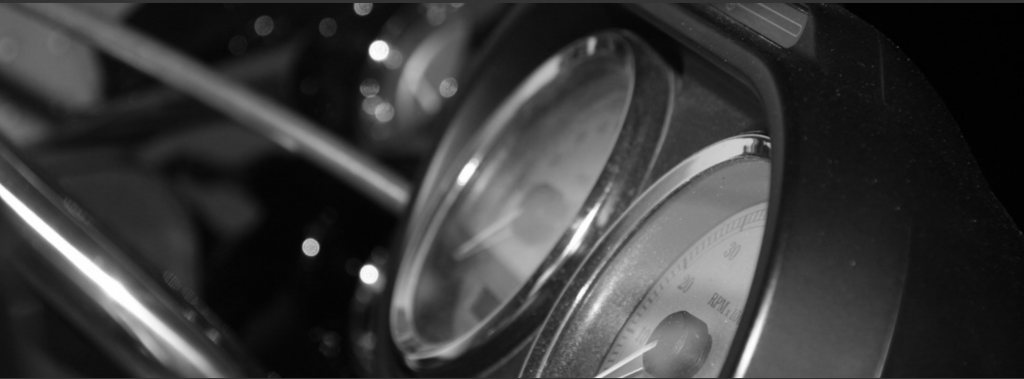
Still, some unfriendly stereotypes remain.
“There was a cartoon going around,” Shannon recalled. “The caption was ‘there’s a crack in my windshield’ and the picture was the rear end of a woman riding second seat in a thong. Her butt crack was the crack in the windshield.”
But public perception of female motorcyclists has shown improvement overall. Sixty-six percent of female motorcycle owners report that their friends and family would have a positive attitude towards motorcycles and scooters, according to an MIC survey.
“Here in southern New Jersey I don’t see being like you’re looked down upon, being a female rider,” said McCarrick. “I actually think some people look up at you.”
The motorcycle world is no stranger to stigma. Its history is filled with the formation of stigmas, and bikers who fought against them.
The History
The motorcycle’s roots can be traced back to the 1800s. In 1903, the iconic brand Harley-Davidson made their first motorcycle available to the public. Today, it’s the oldest continuously operating motorcycle company in the United States.
Despite common perceptions, women have been riding motorcycles since some of the earliest days of their existence.
“Women were riding motocross in competition and they would disguise themselves as men,” said Dr. Amy Denis, author of the dissertation Outlaws and Angels: Women in motorcycle culture.
In 1940, Robinson and Dugeau established the Motor Maids.
Robinson was known for painting her motorcycle pink and wearing a pink uniform.
“Her makeup was pristine. Her hair was perfect. Everything was perfect,” said Vuolo. “And one of the older women told me that that’s because Dot used to tell the women, before you get to your location, pull off at any place – a gas station, anywhere where there’s a bathroom. Re-apply your makeup, fix your hair and if you need to change, change.”
The motorcycle industry also played a significant role in the war effort during WWI and WWII. During the U.S. involvement in WWII, many American women were challenging traditional gender norms through their contributions to the war effort. This included female bikers like Bessie Stringfield.
“Stringfield was a Black woman who owned a Harley-Davidson, and she rode cross-country delivering messages for the service for the armed forces on her motorcycle,” said Denis.
Many men returned home from WWII seeking the brotherhood they found as soldiers. This helped pave the way for motorcycle clubs to emerge.
Among these emerging clubs were so-called “outlaw motorcycle clubs.”
“As clubs began to evolve, the roles of women began to shift to a more demeaning role provided by outlaw motorcycle clubs,” Denis wrote in her dissertation.
Despite being a minority in the motorcycle world, outlaw clubs received a disproportionately high amount of media attention. Consequently, the way they often treated women affected public perceptions of female bikers. And even today, historic female motorcyclists like Stringfield, Robinson and Dugeau aren’t as widely known as many of those who dominated the media around the postwar era.
“The contrasts from the 1940s biker women to the 1960s image Americans were getting was vast,” Denis wrote in her dissertation. “Between the post-World Ware Motor Maids and the newly forming Vietnam era counter culture, the image of women had changed very drastically.”
Hell’s Angels is perhaps one of the most well-known outlaw biker groups around. In 1957, Sonny Barger, one of the founding members, decided that women should no longer be allowed as memebers.
“I felt we didn’t need girls in our club,” Barger wrote in his book, “Hell’s Angel: The Life and Times of Sonny Barger and the Hell’s Angels Motorcycle Club.” “Women couldn’t defend the patch. It’s a stamina thing, keeping up as a fighter and as a rider. We have women who ride just as well as the members. Some of them can ride better than me, but when it comes down to riding hundreds and hundreds of miles in one day, they’re just not going to do it.”
One of the most infamous trends among many outlaw clubs was the use of property patches. Women who dated or married club members could wear the club’s colors, but they would wear patches saying “property of [husband/boyfriend’s name].” For these women, wearing the patches often stopped other men from messing with them.
All sorts of circumstances attracted people to these clubs. For instance, the clubs sometimes offered an escape from the mass domesticity of the postwar era, to which many Americans had trouble adjusting.
“There were a lot of girls getting involved, too, with the biker clubs – the younger girls rebelling, not wanting to be pushed into these roles,” said Denis. “Your mom is a stay at home mom and your life is supposed to be in the kitchen. And these girls are going, ‘no.’ And you have this kind of rebel without a cause rebellion happening, where these girls are kind of escaping into the roles in these biker clubs.”
However, many outlaw clubs like the Hell’s Angels have since improved their reputation, including. when it comes to how women are treated.
“I think the bikers of the 80s were just beginning to make that switch to what we see today, which is a much less violent, more philanthropic and – for lack of a better term, dare I say – domestic type of co-existence with mainstream society,” Denis said. “They are much less brazen with the on-goings within the clubs, therefore do not require the media attention.”
Nonetheless, outlaw clubs certainly do not bear all the blame for the stigmas towards female bikers. They also don’t bear all the blame for popular depictions of bikers as reckless. The media also played a major role in thise.
A famous example of this was the so-called Hollister Riots. The AMA hosted a Fourth of July tour event in 1947 in Hollister, California. Many details of the event are unclear. But the event did produce a very high turnout. However, the media sensationalized what happened during the event. One photo taken during the event is still quite famous today.
“Somebody got on a bike and they [the photographers] but beer bottles all around him on the ground,” said Denis. “And it was staged but it made like they made this big scene like these guys were fighting and causing a ruckus and making the bar owners scared, hence feeding into this demonization.”
Hollywood also played on the image of outlaw clubs with moves like “The Wild One,” a 1953 film starring Marlin Brando.
It was also common to depict female bikers in a very sexualized light around this time.
“You had Easyriders magazine who would always have women half naked, some of the mostly naked, on motorcycles,” said Denis. “Easyriders was one of the infamous ones.”
But around the 1980s, many bikers effectively worked to reclaim their narrative.
During the late 70s and 80s, many all-female clubs emerged that are still around today. Some examples include Women in the Wind, which was founded in 1979, Women on Wheels, which was founded in 1982 and Sirens MC of New York City, which was founded in 1986. Sirens MC of New York City advocate for the LGBTQ community and make appearances at pride parades.
In 1999, the women’s magazine Women Riders Now (WRN) was founded. They are now solely online and their content is available to read for free. Many companies advertise with them as a means of reaching out to female bikers. The outlet “has more page views and more unique visitors than any other website, blog, or magazine that’s primarily aimed at women motorcycle riders,” according to their website.
The Industry
When it comes to motorcyle ownership, the bike itself is only one of many important investments a rider must make.
The AARP recommends that people wear a helmet, eye protection, jacket, gloves, pants and boots every time they ride a motorcycle. They also recommend bikers keep rain gear handy in case the weather acts up.
“When it comes to clothing, we always say, ‘leather is a lot more sturdy than your skin,'” said Veale.
Vuolo remembers how hard finding women’s gear used to be.
“In the old days, we didn’t have anything,” she said. “When I started riding, I remember I needed a coat and I couldn’t find any women’s coats.”
Fortunately, more women’s gear has become available over the years.
“The manufacturers are producing this stuff,” said Veale. “If you came in here ten years ago, maybe you’d find a women’s jacket and a men’s jacket. Now, you find a lot more selection.”
“I’m seeing more jackets geared toward the fit for a woman and warmth and comfortability,” sad Denis. “I’m definitely seeing more practical choices more than it is a fashion accessory. Like, who’s going to ride in a half shirt?”
Sexual pictures of women on bikes are still around.
“Yes, there are still pin-up girls, and no, women are still not very upset by that image, as long as we aren’t treated like them when we pull up on our own bikes,” Denis wrote in her disseration.
But what about the bikes themselves?
Women Riders Now used surveys and reader input to formulate a list of the top ten most popular motorcycles for women. The Harley-Davidson Sportster 883 SuperLow came in first place.
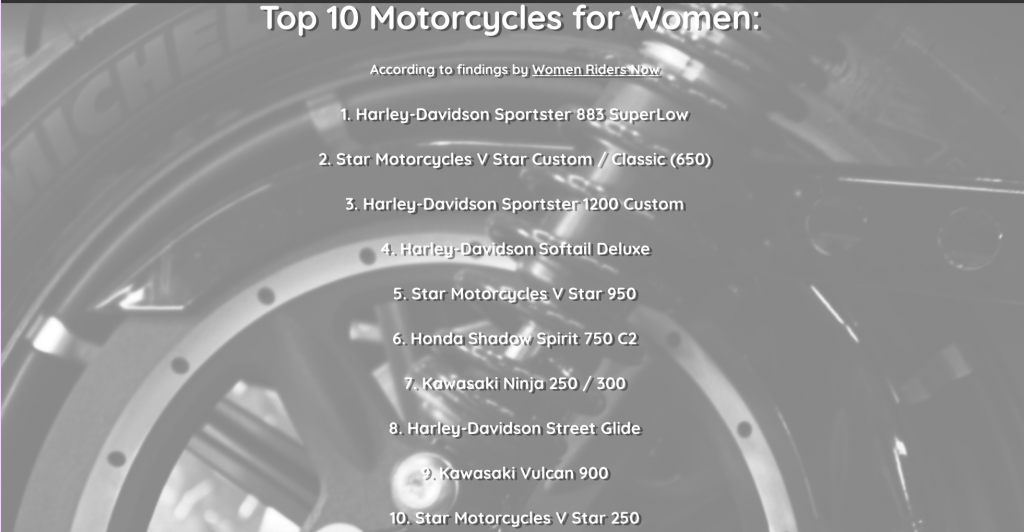
“Harley has the largest market share, just across the board of riders in the country,” sad Medina. “And we’ve actually seen that market share grow. The market itself has shrunk, but our share has increased. And female riders make up about eight percent of that.”
But the rising percentage of female motorcycle owners is only one of the changes this industry has seen throughout the years.

“I’ve been riding dirt bike races since I was four or five,” said Coutsourakis. “I eventually got bigger ones, went on the track, and then I got my first real Harley when I was 17 over Christmas.”
Attracting people like Coutsourakis has long been a major concern for the motorcycle industry. The median age of motorcycle owners has risen from 32 in 1990 to 50 in 2018, according to the MIC.
This industry has been one of many that millenials have been accused of killing. The cost of motorcycle ownership is often thought to be one of the reasons why it has been difficult to get young adults to buy motorcycles.
“The real challenge down the road, and the folks in Milwaukee are working on this, is to produce less expensive motorcycles,” said Medina.
Conclusion
“I did a ride down in George,” Vuolo recalled. “And Dot [Robinson]’s daughter was still alive… and she rode up and she had the bike because she would always ride that pink bike with the pink sidecar.”
Dot Robinson kept on riding until she was 85 years old, according to the Motorcycle Museum. She passed away in 1999 at the age of 87. Dugeau passed away in 2000 at the age of 86, also according to the Motorcycle Museum.
Women have come a long way in the motorcycle world. Leading ladies such as Stringfield, Robinson and Dugeau have all found their way into the AMA Hall of Fame. Other female inductees include Women in the Wind founder Becky Brown, former Motor Maids president Mary Shephard Cutright, co-founder of Harley Women Magazine Linda Giovannoni and more.
So much about the motorcycle world is changing. But some things remain. For many men and women alike who swing their leg over a bike, the feeling of freedome when they ride simply never gets old.
“When you’re riding down the road and it’s a beautiful summer day, it’s just being free,” said Green. “It’s just totally freeing and calming, and you can be with your thoughts. It’s just a really fun thing to do.
